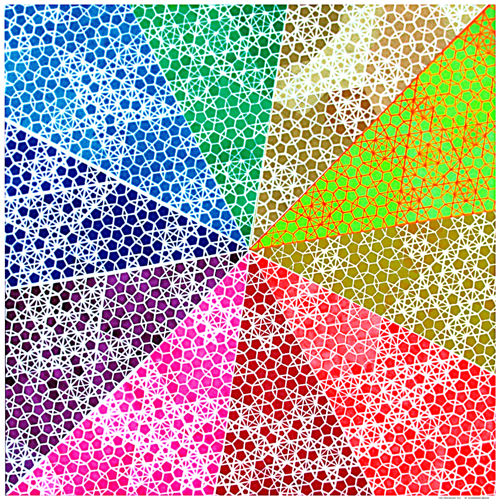File:Pentagon tile by Alexander Braun first mandala.png
Pentagon_tile_by_Alexander_Braun_first_mandala.png (500 × 500 pixels, file size: 662 KB, MIME type: image/png)
| This is a file from the Wikimedia Commons. Information from its description page there is shown below. Commons is a freely licensed media file repository. You can help. |
Summary
| DescriptionPentagon tile by Alexander Braun first mandala.png |
English: I made this first pentagon mandala painting for a commission using a stencil I have cut out back in December 28-31, 2004 while living on a hundred acres farm in Kleinberg, Ontario near Toronto. This painting is still the largest rendering of the pentagon tile in existence today. |
| Date | |
| Source | digital photograph I made of my painting 60"x60" fluorescent acrylic on canvas (2005). Commissioned for private collection. |
| Author | Alexander Braun |
| Other versions | http://en.wikipedia.org/wiki/File:Pentagontile2-icn.png |
- Quasi-crystal x-ray photo.
- Pentagon tile XXVII (isosceles fractals) - Commons file.
- Pentagon tile II (first mandala) - Wikipedia file.
- Pentagon tile by Alexander Braun on exhibit at the Museum Of Contemporary Canadian Art (MOCCA) in Toronto, Ontario, Canada.
- Wikipedia featured picture candidates - AlexanderBraun
Press Release
New pentagon pattern discovered by a Toronto artist.
It is impossible to tile a pentagon with the same size pentagons in 2D plane without leaving unaccounted for space. By many many attempts were made to come up with a way to tile this basic geometric shape and some were successful, others managed to design nice images containing no tile pattern algorithm.
On December 28, 2004, I was visiting my long-time friend Yehudah Lionel Cullman who showed me an [x-ray photo of a quasi-crystal] forming five-sided symmetry in a science book and said, that as far as he is aware there is still no known way to tile a pentagon. Inspired by an x-ray picture and challenged by a mystery of the pentagon tile I started to chart my attempt at the impossible. I have realized that the only way to tile a pentagon with only one size pentagons would be in 3D forming the fifth Platonic volume - dodecahedron (i.e. "two plus ten faces" in Greek), where the twelve pentagons enclose 3D space. Still, curious, I decided to try to design a pentagon pattern.
I have noticed that at the centre of quasi-crystal photo were ten dots forming pentagons aligned in a perfect circle arranged as a ten-pointed star. The fact that here I see ten pentagons in a circle gave me an idea that if I only tile 1/10th slice of it, which is 360/10=36 degrees, then it would be enough to create a tile pattern.
So, I drew one 36 degrees slice of infinity and placed one pentagon at the bottom corner of it where it perfectly matches the 108 degrees of the inner pentagon angles. The rest came in place naturally, as I just continued the pentagon lines to determine what other basic building shapes of the tile are there at the very bottom of the pentagon slice. Then I have discovered that only two isosceles triangles in golden mean to each other, with angles of 36'-72'-72' and 108'-36'-36' degrees, form the pentagon tile pattern. Therefore these two triangles can form a pentagon, or a star, or a perpetual fractal pentagonal pattern.
The main dilemma for many who have tried to organize pentagons in a pattern is what to do with the unaccounted for space. In my attempt at it I have soon realized that the unaccounted space between pentagons when tiled within the 36 degrees slices form perfect stars, pentagrams, which makes total sense since it is the shape contained within the pentagon boundaries. The next challenge was to figure out the actual tiling algorithm of the pentagon tile's perpetual expansion of its infinite outer rings. I realized that whatever happens at the bottom is what happens at the top of it, only on a different scale. Soon I noticed that the ring of pentagons is followed by a ring of stars and then by pentagons again in a perpetual rotation based on the power of six, i.e. 6x6x6...:
* 1, * 6, * 36, * 216, * 1296, * 7776, * 46656, * 1679616, * 60466176, * 2176782336, * 78364164096, * 2821109907456, * 101559956668416,
etc."
Alexander Braun theUniverse.name
Licensing
- You are free:
- to share – to copy, distribute and transmit the work
- to remix – to adapt the work
- Under the following conditions:
- attribution – You must give appropriate credit, provide a link to the license, and indicate if changes were made. You may do so in any reasonable manner, but not in any way that suggests the licensor endorses you or your use.
- share alike – If you remix, transform, or build upon the material, you must distribute your contributions under the same or compatible license as the original.

|
Permission is granted to copy, distribute and/or modify this document under the terms of the GNU Free Documentation License, Version 1.2 or any later version published by the Free Software Foundation; with no Invariant Sections, no Front-Cover Texts, and no Back-Cover Texts. A copy of the license is included in the section entitled GNU Free Documentation License.http://www.gnu.org/copyleft/fdl.htmlGFDLGNU Free Documentation Licensetruetrue |
Captions
Items portrayed in this file
depicts
2 June 2005
File history
Click on a date/time to view the file as it appeared at that time.
| Date/Time | Thumbnail | Dimensions | User | Comment | |
|---|---|---|---|---|---|
| current | 20:35, 30 March 2009 |  | 500 × 500 (662 KB) | Atumtem | {{Information |Description={{en|1=I made this first pentagon mandala painting for a commission using a stencil I have cut out back in December 28-31, 2004 while living on a hundred acres farm in Kleinberg, Ontario near Toronto. This painting is still the |
File usage
The following page uses this file:

